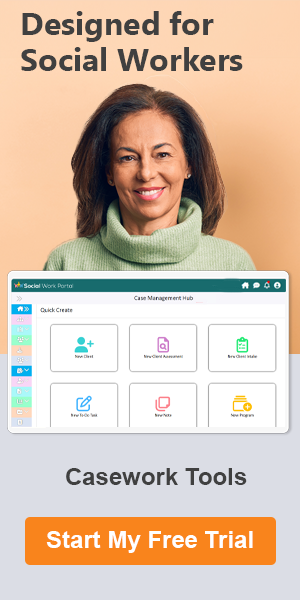How Do Social Workers Really Do Eco Mapping In Social Work?
What is an Ecomap in Social Work Really Used for? The Key Social Worker Tools You Need to be Aware of.
An ecomap assessment tool is one of those types of assessments that social workers keep in their “toolbox.” They use ecomaps to conduct social work assessments to gather valuable information that may be contributing to a client’s problem.
One of the most important reasons why eco mapping in social work are so popular is that they are very easy to use, and provide great, insightful results. So, whether doing an ecomap for one person or a whole family, it’s something that most social workers can create easily, and often do!

See Also: Detailed Social Worker Assessment Guide
Table of Contents – What You Need to Know about Ecomaps in Social Work
Below, we’ll answer some of the common questions about ecomaps, including:
- What is an ecomap in social work?
- What does an eco map social work example look like?
- Why use eco mapping in social work? Ecomap examples
- Can I download a free ecomap social work PDF?
- Ecomap template & social work assessment tool
- Eco Mapping & Eco Map Social Work FAQs
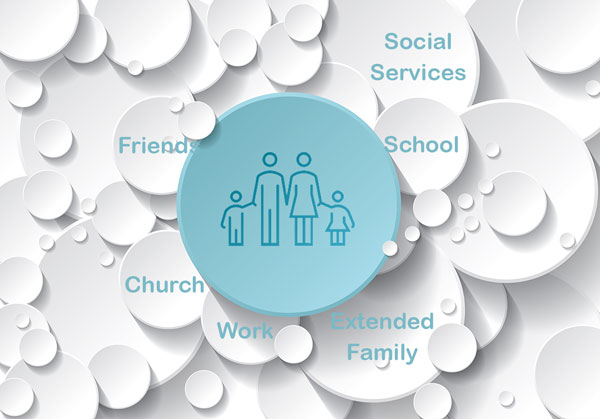
What is ecomap in social work?
Don’t Miss: Different Social Workers You May See & What They Do
Do you have additional examples of ecomaps in social work you would like us to list in this article? Let us know.
What Is an Ecomap in Social Work Assessment?
An ecomap in social work (also referred to as eco map or eco-map) is a visual representation of all the different systems impacting an individual’s or family’s life.
People interact with multiple other entities regularly, including friends, extended family, work, school, recreational clubs, medical professionals, etc.
This is the person’s “ecosystem.” Eco mapping in social work makes that ecosystem easier to understand and provides more insights into the relationships themselves.
For example, if a social worker is providing clinical therapy and referral services for someone that is a habitual drug user, they will want to see what influences are in their life that can either help or hinder their recovery.
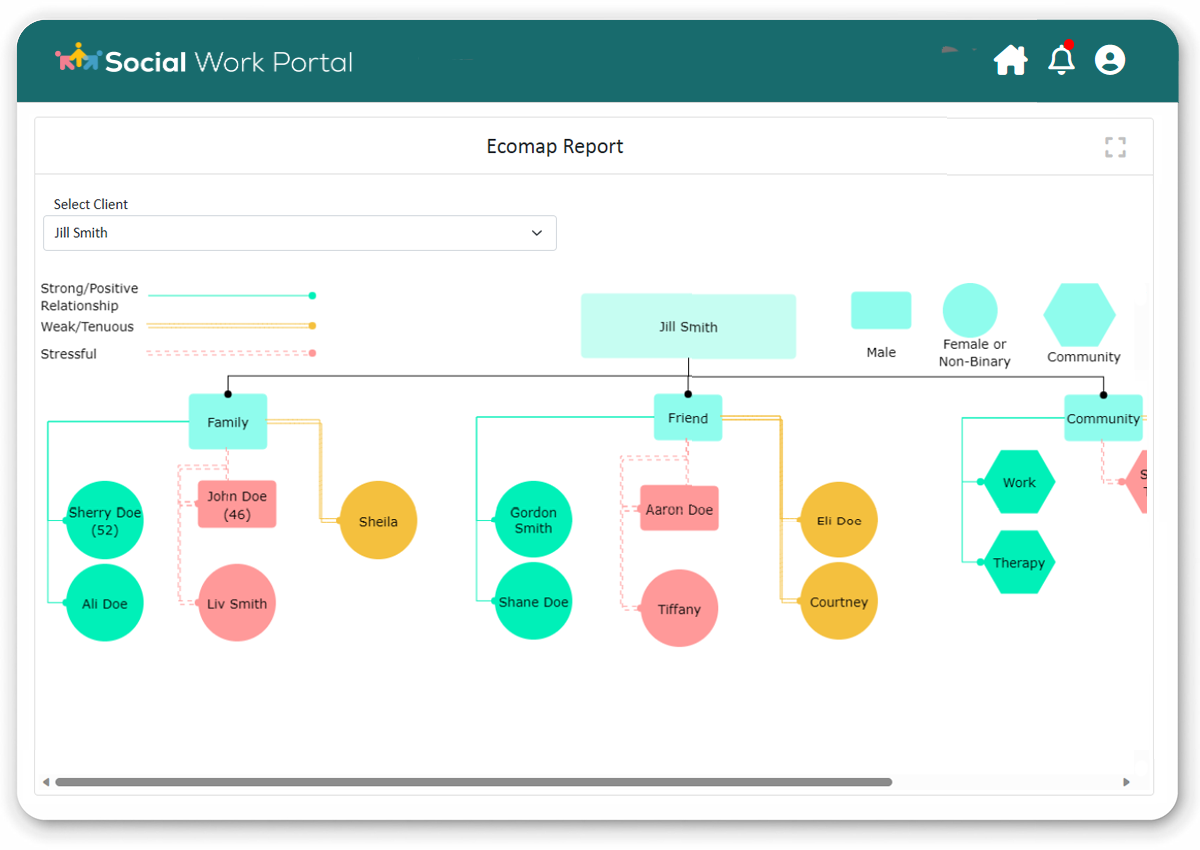 | Get an Ecomap Report & More x Subscribe to our Social Worker Toolkit |
An ecomap example social work assessment allows that social worker to immediately identify the stressful or negative influences in that person’s life, as well as those that are positive and areas of support. This is indicated by the use of connector lines and how they look. (We’ll cover this next.)
An eco map social work assessment is sometimes confused with a genogram because some types of social work genograms will use the same types of relationship lines.
It’s not surprising for someone to accidentally call this assessment an ecogram social work tool rather than an ecomap. Later, we’ll provide an ecomap social work example that actually combines both the genogram and ecomap into one comprehensive report.

Related: Social Work Examples, Methods, & Models
Do you have any questions or feedback on this article on an example of ecomap in social work or the confusion between an ecomap, genogram, and ecogram social work assessment? Are you looking for eco maps social work templates? If so, click here to contact us.
What Do Eco Maps in Social Work Look Like?
Many sample ecomap images that you see will represent the ecomap social work visual as one big circle with several smaller circles surrounding it.
The circle in the center of the social work ecomap template will be for the individual or family being assessed. The smaller surrounding circles will be used to indicate the ecosystem of that family or individual.
Between the circles in the eco map social work example will be connector lines. The type of line you use will indicate the emotional impact of that relationship.

The three standard line types that are used are:
- Solid line: Positive relationship
- Dashed line: Weak or tenuous relationship
- Jagged line: Stressful relationship
You can color the lines as well if you like to enhance your ecomap social work example report to be more comprehensive. Some ecomaps also use arrows with lines to represent resources or energy flow between connections.
Here’s how the whole social work ecomap example template looks when the circles and lines are put together.
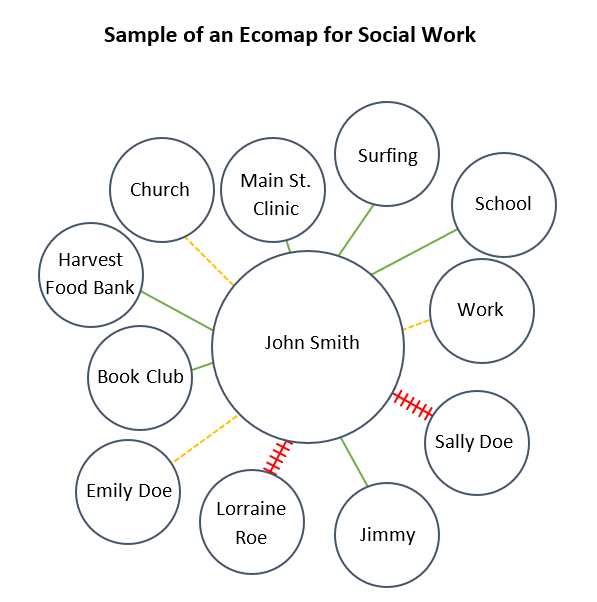
Sample ecomap from the Social Work Portal free ecomap social work PDF and Word template.
Are you ready to level-up your client engagement with more meaningful reports and tools? Subscribe to Case Management Hub software today.
What Types of Connections Should You Include in Your Ecomap Social Work Template?
For your ecomap template social work report, you can include any influencing entities in the ecosystem of your client. It’s helpful if you separate them into two groups – one being friends and the other being community.
The community group in your ecomap example social work template can include things like:
- School
- Work
- Church
- Hobbies
- Sports activities
- Social service agencies
- Medical health services
- Clubs
What about family?
Family connections are also very important, and they can be included in the ecomap for one person by putting them in smaller circles surrounding the larger one. If you are doing an ecomap for a family, then you can just include all family member names in the main circle.
There is another type of assessment called a genogram that is used to map family connections. You can review our article, “Best Social Work Genogram Guide with Samples – Everything You Need” to learn more about that.
Case Management Software – Ecomap Report – Assessment Forms Sign up today! | |
Another Type of Social Work Ecomap Example
You do not have to use a large circle surrounded by smaller circles for your social work ecomap template if you’d rather go with a hierarchical view.
Even though many examples of ecomaps in social work use circles, the goal is simply to map the connections and see how they impact your client. You can do this in any way that works best for you.
Here is one of the examples of ecomaps in social work that use a hierarchy instead. This sample ecomap from the Social Work Portal’s Client & Case Management Hub cloud tool includes a combined genogram and social work ecomap template.
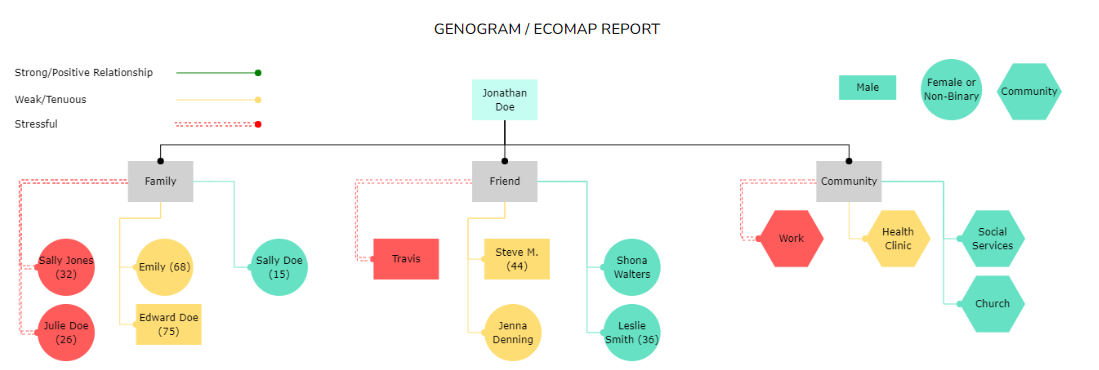
Example of an ecomap in social work using a hierarchy.

Popular Article: Social Work Evaluation Methods | Practice, Program, and Tools
Do you have any questions or feedback about eco map social work templates or types, or an example of an ecomap? Do you know of any other tips for eco maps in social work? If so, click here to contact us.
Why Are Ecomaps in Social Work Used?
An ecomap assessment tool to create eco maps in social work has many uses. Whether creating an ecomap for one person or a family, they provide a lot of helpful insights into relationship dynamics happening in the daily life of the client.
The benefit of using an ecomap social work graphic rather than a text version of the same information is that it makes it easier to visualize the ecosystem for the client. Without the visual provided by ecomaps in social work, positive or negative influencers might be missed.
Here are some of the common uses for a social work ecomap:
- To understand family dynamics
- To view an individual’s connections to the community
- To understand other social support systems the client may be using
- To identify areas of deprivation where resources may be needed
- To uncover areas of service duplication
- For identifying positive and negative influences in a client’s life
- To find potential people or community organizations that can serve as support for the individual’s care plan
- To uncover potential areas of growth for a client
- As a therapy tool with the client to help them see their environment in a different way
Read More: What Are the Real Responsibilities of a Social Worker?
Contact us if you have any questions or feedback about this ecomap in social work guide or are looking for eco maps social work templates. Also, if you would like to provide more examples of ecomaps in social work, feel free to reach out.
Ecomap Social Work Template (Free to Download and Use)
If you’d like a basic ecomap social work PDF or MS Word template that will allow you to create your own ecomaps, we have a free download for you below. It includes reference lines to use for the three main relationship types used in social work ecomap examples.
On the first page, you’ll find an ecomap social work template to use, and on the second page is an eco map social work example assessment to reference.
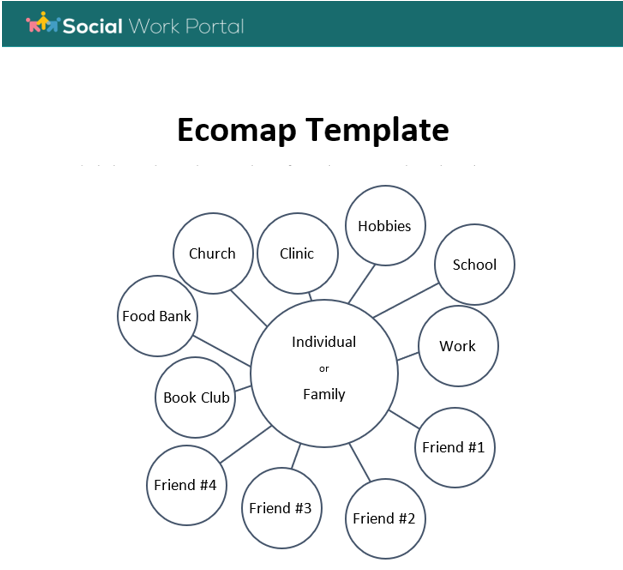
View and Download all Social Work Free Tools including the Ecomap here: Free Social Worker Tools (All of Them).
Related: In-Person & Online Social Work Programs That Get Consistently High Marks
Conclusion | What is Ecomap in Social Work?
When working with individuals and families to provide social services, it’s important to understand all the influencing factors in their lives. Ecomaps in social work provide that valuable insight by illustrating all outside connections and the relationship health of each one.
When eco mapping in social work is combined with a genogram map, it can be even more informative because it also allows you to see the family connections alongside the others.
We hope this article about an example of an ecomap and eco maps social work templates has been a great introduction for you to the world of ecomaps in social work. If you have any questions or comments, please don’t hesitate to contact us.

Don’t Miss: how to become a family support worker (Introduction to Social Work).
Would you like to print this page out as an ecomap social work pdf? No worries, just use your browser’s print to PDF feature.
Eco Mapping & Eco Map Social Work FAQ
What is an eco map social work assessment?
An ecomap in social work is a visual representation of all the different systems impacting an individual’s or family’s life.
People interact with multiple other entities regularly, including friends, extended family, work, school, recreational clubs, medical professionals, etc.
This is the person’s “ecosystem.” Eco mapping in social work makes that ecosystem easier to understand and provides more insights into the relationships themselves.
How do you make eco maps in social work?
You can use a Word document, PowerPoint, spreadsheet, or cloud-based tool to create ecomaps in social work.
Many sample ecomap images that you see will represent the ecomap social work visual as one big circle with several smaller circles surrounding it.
The circle in the center of the social work ecomap template will be for the individual or family being assessed. The smaller surrounding circles will be used to indicate the friends and community connections of that family or individual.
Ecomaps can also be done in a hierarchy graphic instead of circles.
Why are ecomaps important in social work?
An ecomap assessment tool to create eco maps in social work has many uses. Whether creating an ecomap for one person or a family, they provide a lot of helpful insights into relationships dynamics happening in the daily life of the client.
What is the point of an ecomap?
The benefit of using an ecomap social work graphic rather than a text version of the same information is that it makes it easier to visualize the ecosystem for the client. Without the visual provided by ecomaps in social work, positive or negative influencers might be missed.
Note: Content on this website (socialworkportal.com) is copyrighted and protected under applicable copyright laws. Unauthorized reproduction, distribution, or use of any content from the website, without explicit written permission, is strictly prohibited. Read: Terms of Use.
Social Work Portal Disclaimer: Social Work Portal is not a social work agency and we do not refer social workers. This web site is provided for educational and informational purposes only and does not constitute providing medical advice or professional social and healthcare services. The information provided should not be used for diagnosing or treating a health problem or disease, and those seeking personal medical advice should consult with ... Read our full disclaimer here: Social Work Portal Disclaimer.

Image sources:
- Stock.adobe.com

